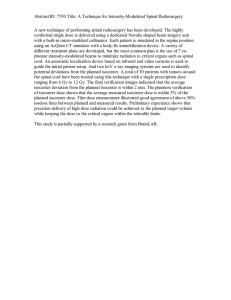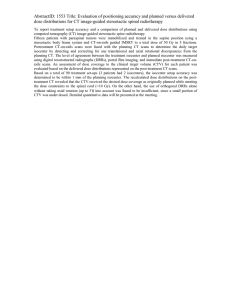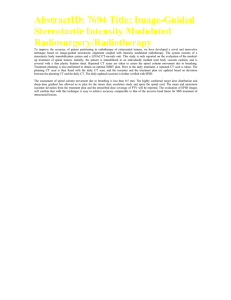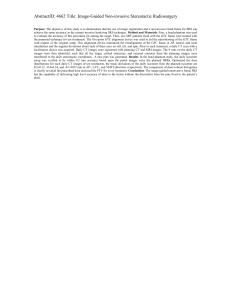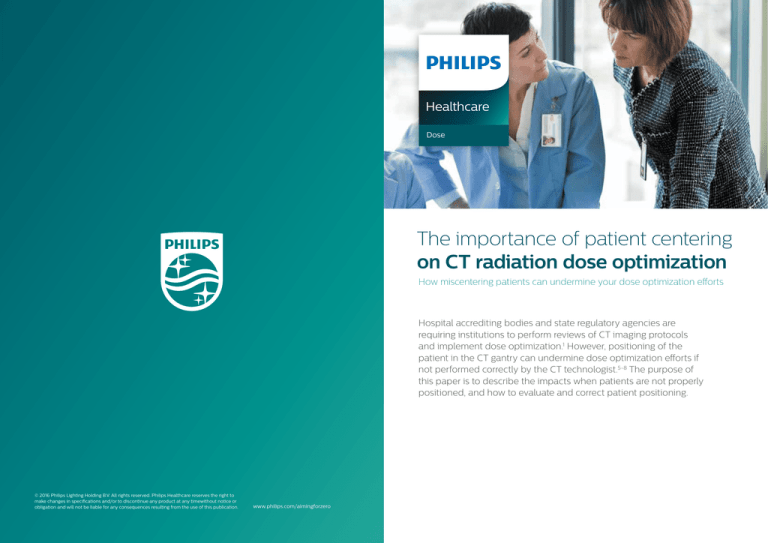
Healthcare
Dose
The importance of patient centering
on CT radiation dose optimization
How miscentering patients can undermine your dose optimization efforts
Hospital accrediting bodies and state regulatory agencies are
requiring institutions to perform reviews of CT imaging protocols
and implement dose optimization.1 However, positioning of the
patient in the CT gantry can undermine dose optimization efforts if
not performed correctly by the CT technologist.5-8 The purpose of
this paper is to describe the impacts when patients are not properly
positioned, and how to evaluate and correct patient positioning.
© 2016 Philips Lighting Holding B.V. All rights reserved. Philips Healthcare reserves the right to
make changes in specifications and/or to discontinue any product at any timewithout notice or
obligation and will not be liable for any consequences resulting from the use of this publication.
www.philips.com/aimingforzero
140
However, studies have shown that technologists
frequently do not position the center of the
patient with the iso-center of the scanner.5-8
Retrospective studies have shown that patient
off-centering is less prevalent in the x,y direction,
and most pronounced in the vertical direction.
In one study, 67-85% of patients were
miscentered more than 1 cm below isocenter.7
Patient size has been observed to influence
whether the patient is not centered properly.
Patients above isocenter tended to be larger
than those positioned below isocenter.7 And,
small patients are more likely to be miscentered
than large patients.5
When a patient is placed on the CT scanner,
the technologist uses their best judgment to
ensure the patient is centered within the gantry.2
Proper positioning of the patient in the gantry
means that the patient midline (an imaginary line
drawn between the patients eyes to their pubic
symphysis) is in the center of the CT bed, and that
the table height is adjusted so the center of mass
of the region to be scanned is coincident with the
center of rotation of the CT scanner.7 Currently,
most modern scanners use lasers to aid the
technologist in positioning the patient. After the
patient is positioned on the bed, the technologist
retreats to the CT console and performs a “scout”
image of the patient so the appropriate region
of interest can be selected for the diagnostic
scan. Technologists may perform either an
anterior-posterior scout image, or a lateral scout
image, or both. The purpose of the scout image
is to measure the attenuation characteristics
of the patient so the scanner can employ the
appropriate automatic exposure controls (AEC).
These scout images provide an opportunity to
verify correct patient positioning. After adjusting
the height of the table the technologist should
“rescout” the patient to ensure proper AEC is used.
120
Number of patients
How a patient is positioned for a CT scan?
Current state-of-the-art CT scanners employ
bowtie filters for the purpose of shaping the x-ray
intensity used to produce the x-ray image based
on the attenuation characteristics of the exposed
tissue region of the patient; in areas of higher
attenuation, a thinner segment of the bowtie
filter is used to increase x-ray intensity, and in
areas of lower attenuation a thicker segment of
the filter is used to reduce the intensity.9 However,
optimal use of the bowtie filter is based on the
presumption that the patient centroid is properly
centered in the scanner’s field-of-view (FOV).5-8
100
80
60
40
20
0
0-5mm
6-10mm
11-20mm
21-30mm
>31mm
Distance of miscenter
Figure 2: Number of patients miscentered by different distances. (adapted from Kim, 2012)
What is the impact when a patient is not
properly positioned?
Patients that are not properly centered do not
have their center of mass properly aligned with
the center of the bowtie filter which affects
the attenuation of the x-ray beam and image
noise.5-8 As a result, dose optimization efforts to
reduce radiation dose while maintaining image
noise may be compromised in miscentered
patients.3,4,6,8 In phantom studies, the peripheral
and radiation dose increased by 12% and 18%
in phantoms 30 mm below isocenter, and
41% and 49% when the phantom was 60 mm
below isocenter.8 Image noise in phantoms
also increased by 16.5% when patients were
miscentered (above or below isocenter) by
30 mm. In general, for patients centered
above isocenter the center of the bowtie filter
corresponds to the posterior abdominal wall
and the anterior abdominal wall receives a more
attenuated x-ray beam.5,6,8 When patients are
centered below isocenter, as seen in Figure
1 below, an increase in posterior abdominal
wall noise is seen as the x-ray beam is more
attenuated by the thicker portion of the
bowtie filter.
Figure 2 presents the results of a retrospective
study which evaluated the distance that patients
were miscentered. One third of all patients were
miscentered between 1 to 2 cm with 16% greater
than 3 cm. Overall, 81% of 395 patients evaluated
were considered miscentered (i.e., >5 mm).
Table 1 presents the results of a separate study
of seven imaging centers. The results for the
number of patients miscentered are similar.
Miscentering of patients has a greater impact
on radiation dose than it does on image noise.
the technologist acquires an anterior-posterior
image. The technologist uses the anteriorposterior image to select the field-of-view (FOV)
for the diagnostic image and reconstruction.
The anterior-posterior localizer image default is
to present the FOV center as the center of the
displayed scan. If the technologist identifies
that the patient is too high or too low from the
localizer, the technologist should lower or raise
the table. Table height adjustments may be
accomplished remotely with most scanners. After
the table position is adjusted, the technologist
should “rescout” the patient to ensure the
scanner recalculates the automatic exposure
control needed for optimum image quality.
Imaging site
Number
of
patients
Average
miscentering
(mm)
Average
dose
increase
Average
noise
increase
1
80
21
21.9%
6.0%
2
33
37
29.1%
10.9%
References
3
89
25
25.0%
7.6%
[1] The Joint Commission (2015). Prepublication Requirements – Revised
4
78
15
17.6%
5.3%
5
72
17
21.9%
6.7%
6
45
24
24.4%
7.8%
7
83
19
19.8%
4.7%
Requirements for Diagnostic Imaging Services. Issued 9 January 2015.
[2] Brothers, R. (2011). Tips & Tricks for Safe CT Scans - Good Habits to
Develop. AAPM 2011 Summit on CT Dose.
[3] Cohen, T. (2015). The Effect of Vertical Off-Centering on Breast Dose
During CT Simulation in Accelerated Partial Breast Irradiation Planning.
Radiation Therapist, 9.
Table 1: Average patient miscentering (above or below) and resulting increase
in dose and noise for seven imaging sites. (Habibzadeh, 2011)
Bowtie filter
[4] Gudjonsdottir, J. (2009). Efficient Use of Automatic Exposure
Control Systems in Computed Tomography Requires Correct Patient
Positioning. Acta Radiologica, 8.
[5] Habibzadeh, M. (2010). The Influence of Patient Miscentering on
Anterior
Increased dose
Isocenter
Offcenter
amount
Center of mass
Increased noise
Posterior
Figure 1: Patient centered below isocenter. (adapted from Habibzadeh, 2010)
How do you evaluate whether a patient is
positioned correctly, and what to do when they
are not?
A properly positioned patient has their center
of mass at the isocenter of the CT gantry. In the
initial step, the technologist positions the patient
using the laser positioning assist based on their
professional judgment. The technologist typically
performs a lateral projection localizer to see if
the patient is close to isocenter (<5 mm). Next,
Patient Dose and Image Noise in Two Commerical CT Scanners.
MEDICON 2010, IFBME Proceedings, 4.
[6] Habibzadeh, M. (2011). Impact of miscentering on patient dose and
image noise in x-ray CT imaging: Phantom and clinical studies. Physica
Medica, 9.
[7] Kim, M. (2012). Relationship between patient centering, mean
computed tomography numbers and noise in abdominal computed
tomography: Influence of anthropomorphic parameters. World Journal
of Radiology, 7.
[8] Toth, T. (2007). The Influence of Patient Centering on CT Dose and
Image Noise. Medical Physics, 4.
[9] Liu, F (2014). Dynamic Bowtie for Fan-beam CT

